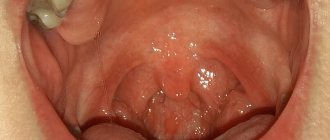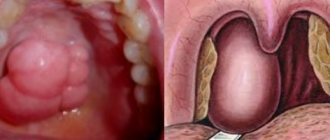Description of the bacterium streptococcus
The bacterium that causes sore throat belongs to the streptococcal group. This is a positive bacterium that causes mainly throat diseases: tonsillitis, pharyngitis, or a combination of both - tonsillopharyngitis. Laryngitis occurs less frequently.
More often, streptococcal infections occur in the cold winter. Infants under six months of age are least familiar with this problem, and the most vulnerable part of the population is children from six to fourteen years old. Adults also get sick, mainly during the cold season.
Reasons - how it enters the body
The main reason streptococcal infection enters the body is ailments of a cold nature. Those who have suffered from acute respiratory viral infections, which have had a difficult course or are not completely cured, become the “progenitors” of colonies of streptococcal bacteria in the throat.
In addition, in adults, infection can be caused by bad habits, especially smoking. Acrid cigarette smoke irritates the mucous membrane of the throat, worsens its immunity, making it more sensitive and susceptible to various microbes.
Video: how to kill bacteria - anti-inflammatory drugs
The video shows the treatment of streptococci in the throat:
The following factors provoke the development of streptococcal infection:
- Heartburn . This is due to the entry of acidic gastric juice into the throat.
- A state of lack of immunity . It can occur due to a serious illness, in the postoperative period, or be a consequence of an unhealthy lifestyle.
- Chemotherapy and long-term use of certain potent drugs also significantly weaken the body's defenses.
It is especially difficult to get rid of streptococci in the throat if a person “picked up” them in the hospital. The fact is that these bacteria are already immune to many types of antibiotics, so it will be much more difficult to cure such an infection.
Sometimes a pregnant woman can become a carrier of hemolytic streptococcus, and upon birth, she can infect him with this infection. In addition, a child can acquire the bacteria at an older age by contracting it from someone in the household. Children who were born prematurely or if the birth occurred with complications are especially likely to get sick.
Children and adults of any age can become infected with both sore throat and streptococci through airborne droplets if a carrier of the infection sneezes or coughs nearby. In addition, sometimes infection is facilitated by the use of shared things, toys, dishes, and household items.
Symptoms of streptococcal infection
What are the signs of a streptococcal infection in the throat?
It should be noted that the incubation period lasts from one to four days. Symptoms may vary depending on the age of the person affected. In children, the development of the disease usually proceeds rapidly, in adults it is slower and more gradual.
Usually the disease begins with a slight malaise: lethargy, a feeling of slight chills, fever.
Infants become capricious, lethargy and drowsiness give way to attacks of anxiety and irritability. Kids refuse to eat. In any case, body temperature rises. Sometimes it can reach 39-40 degrees . Such pronounced fever is usually characteristic of children 3-10 years old.
A runny nose is also inherent in this disease. Moreover, the discharge will be of an unusual greenish-yellow color. Sometimes streptococci cause nausea and vomiting.
It is especially difficult with infants: with older children, you can at least find out what exactly is bothering them.
More signs
Enlarged cervical lymph nodes are a characteristic sign of the presence of streptococci in the throat. Soreness, pain, and a feeling of dryness appear in the throat. Lethargy, drowsiness and apathy are also symptoms of infection. A mild cough also often accompanies the disease. We also recommend that you familiarize yourself with the causes of a sore throat.
A visual examination of the throat clearly demonstrates its redness, and the possible appearance of ulcers on the surface of the tonsils. If a purulent infection develops, your health becomes worse.
The development of an adult streptococcal infection in the throat includes all of the listed symptoms, except perhaps crying and moodiness.
Most often, with this disease, an adult complains of:
- nausea;
- weakness;
- temperature;
- sore throat and swelling;
- lack of appetite;
- enlarged lymph nodes.
If the disease occurs with complications, then streptococci from the throat can enter other respiratory organs, causing infection there too.
So, sometimes streptococcal infection leads to rhinitis, sinusitis, bronchitis, and adenitis. Also, these diseases can occur due to improper treatment of streptococcal throat infection.
But how to treat a red throat in an adult and what treatment is the most effective, this article will help you understand.
For those who want to learn about how to treat a sore throat in a 5-year-old child, you should follow the link and read the contents of this article.
It will also be interesting to learn about how to get rid of snot in the throat: https://prolor.ru/g/lechenie/kak-izbavitsya-ot-soplej-v-gorle.html
But this article will help you understand why mucus accumulates in the throat and what means, including medications, can do this most quickly.
Complications of streptococcal infection
The most severe complications include the following diseases:
- sinusitis;
- inflammation of the middle and inner ear;
- lymphadenitis;
- bronchopneumonia;
- peritonsillar abscess;
- retropharyngeal abscess;
- myocarditis;
- endocarditis;
- glomerulonephritis;
- osteomyelitis;
- meningitis;
- rheumatism.
Complications that occur in the respiratory system usually appear 5–7 days after activation of streptococcus. This picture is a consequence of the lack of treatment with antibacterial agents. As for pathologies such as endocarditis, glomerulonephritis, rheumatism, they are observed after a certain period, approximately 10–20 days from the onset of the disease.
In order to prevent the appearance of dangerous pathologies or to identify them in time, it is necessary to take a general blood and urine test 10 days after suffering from a sore throat. This diagnosis will determine whether there is an inflammatory process in the body and check the condition of the kidneys after an infection. Leukocytosis, lymphocytosis, increased ESR, shift of the leukocyte formula to the left - obvious inflammation. Protein, cylindruria, an increase in the number of leukocytes and erythrocytes in the urine indicate damage to the glomeruli of the kidneys, i.e. The patient is diagnosed with poststreptococcal glomerulonephritis.
Bronchopneumonia can be a dangerous complication. Their insidiousness lies in the fact that the infection can also affect the pleural cavity. As a result of such processes, pleurisy or pleural empyema occurs.
The combination of streptococcal and staphylococcal infections leads to the generalization of sepsis, and this is a step towards death.
Kinds
Let's look at what types of streptococci most often infect the throat.
Hemolytic
This type of bacteria settles on human mucous membranes and skin. If such bacteria are found in the throat, then they may not manifest themselves for a long time, and cause disease only when the immune system is weakened.
Hemolytic streptococcus causes:
- scarlet fever;
- sore throat (streptococcal sore throat is described in detail at the link);
- pneumonia;
- pharyngitis and other diseases.
This type of bacteria is often found in pregnant women. In this case, infection also threatens the baby, who can pick up an infection while passing through the birth canal.
Non-hemolytic or greening
This type of harmful microbes settles in the oral cavity, and sometimes makes up up to 60% of its microflora.
In addition to the throat, viridans streptococcus also settles in the intestines, entering it with the food mass.
This type of microbe causes bacterial endocarditis, caries, and other diseases.
Pyogenic
Streptococci of this type are “based” in the throat, from where they can enter the skin, intestines, and other organs. This is the most dangerous type of microbe. The mortality rate, if the disease has become severe, as a result of infection with pyogenic streptococcus is 25%.
This bacterium causes:
- sore throat;
- pharyngitis;
- scarlet fever;
- erysipelas and other skin lesions.
The incubation period for infection with this type of streptococcus is the shortest - 1-3 days.
Causes of the disease
A streptococcal infection can appear unexpectedly. And it is impossible to protect yourself from infection, because... Streptococci are present invisibly in people's lives and live in colonies in the upper respiratory tract.
The main reasons for the appearance of bacteria are:
- Complication after acute respiratory infections;
- Herpes;
- Purulent sore throat;
- Frequent hypothermia;
- Diseases in the nasopharynx;
- Inflammatory processes on the tonsils;
- Pneumonia;
- Long-term use of hormonal drugs by women;
- Autoimmune diseases;
- Chemotherapy;
- Rejection of gastric juice into the esophagus;
- Bacteria are transmitted by airborne droplets upon contact with an infected person;
- Infection can be caused by eating food without proper heat treatment;
- You can become infected with streptococci if you do not wash your hands before eating;
- Since bacteria live in a person's mouth, infection can occur through kissing;
- Infection occurs if a child has the habit of putting toys in his mouth;
- Streptococcal infections are contracted from pets;
- For throat diseases;
- If the immune system malfunctions;
- If personal hygiene is not observed.
Streptococci are constantly present in the human body. This situation is the norm. They are in a "sleeping" state. And only negative factors can provoke the appearance of an infectious disease.
Treatment for adults
How to get rid of it with antibiotics
Antibiotics for Staphylococcus aureus and strep throat infections are a common treatment option. It is best to use broad-spectrum drugs that can cope with various types of bacteria. The penicillin group of antibiotics is most often used: Ampicillin, Amoxiclav (this article will help you understand what the dosage of Amoxiclav should be for adults with sore throat), Flemoklav. If you are allergic to penicillin, other forms of antibiotics are prescribed: Suprax (how to use Suprax for tracheitis in a child is described in this article), Cephalexin, Azithromycin (what reviews about the use of Azithromycin for angina exist and how positive they are, this article will help you understand) or Erythromycin.
Erythromycin
In addition to antibiotics, the following should be used in treatment:
- antipyretics;
- a large amount of liquid;
- washing and gargling;
- antiseptic and antibacterial agents;
- inhalations and vasoconstrictor drugs.
Traditional methods
Attention: home treatment methods can only be used as an addition to the main one. Properly selected folk methods will ease the course of the disease and speed up recovery: they will relieve inflammation, increase immunity, and weaken infection.
Methods
A warm drink made from rose hips with raspberries perfectly improves the level of immunity.
Willow bark brewed with boiling water is used as an antiseptic for gargling.
Chewing propolis relieves the inflammatory process, since this beekeeping product has pronounced antibacterial properties.
How to treat streptococcal throat infection?
Rinses, inhalations, anti-inflammatory tablets and lozenges will not solve problems with streptococcus alone. The only effective treatment is the use of antibiotics. Ideally, select the right product based on the bacterial culture performed.
The course of treatment with antibacterial drugs ranges from 7 to 14 days. Sometimes intramuscular or intravenous administration of drugs is required. In case of primary infection, they resort to penicillin drugs. Only a doctor can select the drug, taking into account age, weight and severity of the infectious process.
If the patient has intolerance to penicillins, macrolides, for example, azithromycin or erythromycin, as well as drugs from the cephalosporin group can be used:
- suprax, cephalexin,
- moxalactam, ceftibuten,
- cefazolin, ceftriaxone and others.
For scarlet fever, macrolides and cephalosporins remain the drugs of choice. The latter are used for more severe forms of the disease. Antibacterial therapy for scarlet fever lasts from 14 days or more, depending on the severity of the disease. In particularly unstable and complex cases, therapy is supplemented with aminoglycosides.
Together with antibiotics, antipyretics, antiseptics, vasoconstrictors and other drugs prescribed by a doctor are used. To soothe the throat, inhalations, lozenges and painkillers are used.
After the acute period of the disease subsides, the lacunae are washed with antiseptics using special devices. The course requires a minimum of 5 washes twice a year.
Often streptococcus recurs after a course of antibiotics. Then you should change the treatment tactics, possibly replace the antibiotic, undergo additional examinations and involve an immunologist in solving the current problem.
Treatment of children
Drug therapy
Children are also prescribed antibiotics. In this case, penicillin and erythromycin drugs are used:
- bicillin;
Bicillin for injection - ampicillin;
Ampicillin - erythromycin.
Erythromycin
In addition, children are prescribed:
- frequent and abundant warm drinks to remove toxins;
- gargling with antiseptic solutions;
- irrigation with anti-inflammatory sprays;
- Taking vitamin C will boost your immunity.
Traditional methods
Drinking general strengthening decoctions and infusions of medicinal herbs, berries and leaves have a good effect, accelerating recovery. Raspberries, rose hips and cranberries are especially useful for children.
Decoctions of chamomile and eucalyptus are suitable for gargling. Propolis solution can also be successfully used for this purpose. These products have a pronounced antiseptic and astringent effect, helping to quickly eliminate bacteria in the throat.
It is useful for children to dissolve honey in the mouth. But this article will help you understand how to use milk, soda, butter and honey for coughs.
Traditional methods of getting rid of streptococcus
Traditional medicine is used in combination with basic antibacterial treatment. Their task is to help destroy bacterial flora, relieve inflammation, weaken the manifestations of the disease, increase vitality and restore immunity. When using folk remedies, patients note minimal development of complications, which makes it possible to carry out treatment without harm to the body.
The following recipes have been selected to combat streptococcus:
- Buy fresh propolis from beekeepers. Place a small piece in your mouth and chew slowly for about 5-10 minutes. Continue this procedure three times a day for two weeks. Then a break for two weeks, and repeat the treatment again;
- prepare the “Health” drink: cranberries + rose hips (200 grams each). Add 10 raspberry leaves to them. Pour the mixture with a liter of boiling water and keep it on low heat for 5 minutes. Let it sit for 1.5 hours. We drink 200 ml during the day;
- gargling: 10 grams of string + 10 grams of willow bark (mix everything), pour 300 ml of boiling water. We insist for about two hours. Gargle three times a day;
- A water infusion of beets will help relieve inflammation in the throat. To do this, beet pulp is diluted 1:1 with water. Leave for 5–7 hours. You should gargle with the prepared infusion three times a day. It is recommended to add a teaspoon of homemade apple cider vinegar to the rinse. Healers also advise taking 20 ml of beetroot water orally twice a day.
- Is it possible to take a bath when you have a cough?
- Pain in the larynx when swallowing;
- How to breathe over potatoes when you cough.
Danger of infection
Let's find out what the dangers of advanced streptococcal infection are.
Otitis may appear (but what ear drops are the most effective for otitis is described in detail in this article). Sinusitis with sinusitis is also a common complication of the disease. Sometimes a purulent abscess may even develop in the throat.
Pneumonia or bronchitis are the result of improper or untimely treatment of streptococcal throat infections.
If, at the stage of the appearance of these “first level” complications, treatment did not begin or went the wrong way, the following complications may develop:
- glomerulonephritis (severe kidney disease);
- myocarditis (heart damage);
- acute rheumatism;
- osteomyelitis (bone disease);
- meningitis.
In addition to the above, the development of necrotizing lung disease, pleurisy, even sepsis is possible. If a newborn is born underweight, complications due to streptococcal infection sometimes result in death.
Is there a vaccine against streptococcal infection?
Immunization today has not lost its relevance. Vaccines are being developed for streptococcus, but scientists have not yet achieved definite results. Animal studies have shown a number of negative aspects when administering streptococcal vaccines. Provocations of severe immune responses were observed, which in turn led to damage to internal organs in experimental animals. Therefore, such a vaccine should absolutely not be used on humans.
The only way to prevent the development of streptococcal infection is to boost immunity. It is necessary to pay attention to the following points:
- dress according to the weather;
- Healthy food;
- harden;
- exercise measured physical activity;
- maintain personal and home hygiene;
- quit bad habits.
Clinical course and diagnosis
Symptoms will depend on the location where the hemolytic streptococcus is localized.
- If hemolytic streptococci in the throat choose to attack the tonsils, a purulent sore throat will develop, its main symptoms will include:
body temperature is higher than subfebrile, can reach 40 degrees;- upon examination, the tonsils may have white dots or ulcers;
- the child completely refuses to eat; even drinking water causes severe pain;
- swelling of the face and neck;
- enlargement of the submandibular and postauricular lymph nodes.
acute pain when swallowing;
- dry and painful cough without mucus discharge;
acute pain, especially when swallowing;
After determining the symptoms, it is necessary to laboratory confirm streptococci in the throat using the following diagnostic methods:
General blood analysis. It will make it possible to confirm the presence of a bacterial infection. Signs: increased erythrocyte sedimentation rate (ESR), leukocytosis due to the neutrophil fraction, shift of the formula to the left.- Culture from the oropharynx. This method helps to isolate the pathogen.
- Culture for sensitivity to antibiotics. The analysis gives an explanation of how to treat a child or adult: which antibiotics hemolytic streptococcus is resistant to, and which ones can be treated.
It is also worth mentioning complications. These include:
- pneumonia;
- laryngitis;
- otitis;
sinusitis;- meningitis.
These were all early complications; they arise against the background of inadequate therapy, or its absence.
But there are also a number of so-called late complications. Not everyone gets them.
More precisely, it is not enough to have a sore throat; you need to have a certain predisposition to develop diseases such as:
- rheumatism;
- various heart defects;
- acute glomerulonephritis.
Diagnosis of the disease
The simplest and most effective way to determine the presence of streptococci in the mouth is to take a swab from the throat for bacteriological culture. After identifying the disease, the sensitivity of bacteria to antibiotics begins to be determined. The correctness of the selected therapy will completely depend on this.
But the doctor often prescribes a blood test, which allows you to determine the type of pathogen and how far it has spread throughout the body.
Considering that the disease in its acute form is quite dangerous, treatment is most often resorted to at the first visual examination. The doctor prescribes antibiotics without fail, because any type of streptococcus is extremely sensitive to antibiotics.










